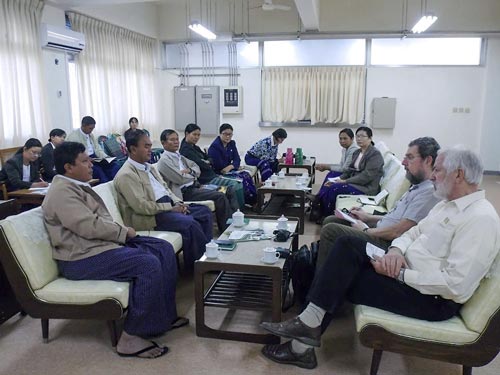Month: February 2015
No scientific basis for criticism of wheat as a food staple, nutritionist says
 Nutrition, health and food security
Nutrition, health and food security
A nutritionist wants to dispel myths generated by claims that the protein found in wheat is unhealthy.
Opportunity: integrating gender in crop research today!
 Gender equality, youth and social inclusion
Gender equality, youth and social inclusion
CIMMYT Gender Specialist Lone Badstue attended a CGIAR Gender Network meeting in the Philippines during 19-23 January. Participants discussed CGIAR’s progress and results in gender research, along with plans for collective, cross-program activities that contribute to CGIAR innovation.
USAID’s Feed the Future initiative highlights CIMMYT heat tolerant maize breeding
 Climate adaptation and mitigation
Climate adaptation and mitigation
The Feed the Future initiative of the U.S. Agency for International Development (USAID) featured CIMMYT’s Heat Tolerant Maize for Asia (HTMA) project in a recent newsletter, highlighting it as an exemplary public-private partnership. Launched in 2013, the project is developing heat-resilient hybrid maize for resource-poor smallholder farmers in South Asia whose livelihoods are threatened by climate change.
Extension bulletins raise awareness of conservation agriculture in Malawi
 Innovations
Innovations
CIMMYT, Washington State University and Total Land Care (TLC) recently published a series of extension bulletins to spread awareness of the potential benefits of conservation agriculture (CA) techniques for farmers in Malawi.
Prioritize food security, not conflict, wheat scientist advises
 Climate adaptation and mitigation
Climate adaptation and mitigation
Heat and drought are a major cause of wheat yield losses worldwide, problems that scientists predict will worsen due to climate change.
DTMA launches new project to improve seed scaling in Eastern Africa
 Climate adaptation and mitigation
Climate adaptation and mitigation
Born out of the Drought Tolerant Maize for Africa (DTMA) Initiative and other CIMMYT-Africa maize projects, the Drought Tolerant Maize for Africa Seed Scaling (DTMASS) project will improve the demand for and availability of high-quality, affordable, certified seed of drought-tolerant maize varieties for small-scale farmers across eastern and southern Africa.
Chief Minister of Bihar assures support to BISA
 Climate adaptation and mitigation
Climate adaptation and mitigation
The Chief Minister of Bihar, India, Shri Jitan Ram Manjhi, affirmed his support for the Borlaug Institute for South Asia (BISA) and its efforts to ensure food security, in a meeting with Thomas A. Lumpkin, director general of CIMMYT, and with government, BISA and CIMMYT representatives on 3 February.
Crop model gives scientists a window on future farming in the Eastern Gangetic Plains
 Capacity development
Capacity development
In work to help farmers in South Asia tackle changing climates and markets through resilient and productive cropping systems, scientists are now using a leading and longstanding model, the Agricultural Production System Simulator (APSIM).
Spreading innovation: new partnerships drive change in Odisha
 Capacity development
Capacity development
The Cereal Systems Initiative for South Asia (CSISA) has collaborated with Digital Green (DG), the Department of Agriculture (DOA), Government of Odisha, Krishi Vigyan Kendras (KVKs) and Orissa University of Agriculture & Technology (OUAT) for a pilot project integrating information and communication technology (ICT)-based video-led dissemination models in 20 villages of Puri district in Odisha, India.
Myanmar and CIMMYT assess needs and joint maize and wheat research
 Innovations
Innovations
Officials of Myanmar’s Ministry of Agriculture and Irrigation and CIMMYT representatives met to strengthen collaboration, with a focus on increasing farm productivity and training a new generation of Myanmar scientists.
Two-wheel tractors to increase smallholder farm power in Ethiopia
 Capacity development
Capacity development
For Ethiopian smallholder farmers who have for millennia used the traditional animal-drawn maresha plow, two-wheel tractors could increase their productivity while reducing labor.
CIMMYT formally welcomes four local workshops to the machinery and equipment innovation group
 Capacity development
Capacity development
In 2014, the work of The Machinery and Equipment Innovation Group begun activities after signing of four contracts with four Mexican workshops.
“No burning in Chiapas” GCAP campaign
 Climate adaptation and mitigation
Climate adaptation and mitigation
“To increase my production, I don’t burn residues; I use them. I practice conservation agriculture.” This slogan was promoted by CIMMYT’s Global Conservation Agriculture Program (GCAP) from March to May 2015 through a communications campaign in the state of Chiapas, Mexico. The campaign aimed to inform farmers and agronomists of the devastating effects of residue burning and its potential risks. It also focused on topics such as the benefits of residue retention, sustainable alternatives to conventional practices, and how burning contributes to global warming.
